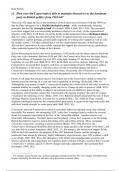Kate Patrick
(i) How were the Conservatives able to maintain themselves as the dominant
party in British politics from 1918-64?
This essay will argue the key to the dominance of the Conservatives between 1918 and 1964 was
that the Party managed to be a ‘ exible ideological canopy’, while simultaneously retaining
principles that had the ‘strength to bind’ (Eccleshall, 1980: 4; Ball, 2013: 518). This generated
cross-class support that was successfully mobilised, relative to its rivals, via the organisational
structure of the Party. I will rstly set out the details of this distinction between ideological pliancy
and core values, arguing that this allowed the Tories to appeal emotively across classes, most
importantly to capture (perhaps, paradoxically) segments of working class support as well as unite
the middle classes. I will then contend that it was the organisational structure of the Party that
allowed the Conservatives to successfully translate this support into electoral success, particularly
when contrasted against the failure of the Liberals.
Before discussing the factors that led to dominance, I will brie y note the sheer extent to which the
Party was in fact dominant. Between 1918 and 1945, the Conservative Party was the single largest
party in the House of Commons for over 90% of the time, winning 5/7 elections with large
majorities of over 200 seats (Ball, 2013: 507). In the three successive elections following 1951, the
Conservatives increased their majority each time; an unprecedented feat for 20th century politics.
For the purposes of this essay, I will aim to draw out the overarching themes that lead to
Conservative dominance over such a broad time frame. Necessarily, this will involve over looking
some of the more speci c factors that may have precipitated success on a case-by-case basis.
Firstly, I will argue that electoral success was largely due to the Conservative ability to re ect the
national mood by drawing on a ‘rich and varied repertoire’ of ideology (Eccleshall, 1980: 4).
Although the very notion of small ‘c’ conservatism implies the conservation of old order, in order to
maintain stability in a rapidly changing world, one has to ‘change in order to preserve’ (Ball, 2013).
One key example of this ability to adapt to the national mood was Baldwin’s peace-loving,
conciliatory, and avuncular manner that ‘represented with singular accuracy’ the spirit of a nation
‘wearied by the sufferings of war’ (Blake, 2010: 216). Baldwin himself articulated this lack of xed
ideology when he claimed that ‘my party has no political bible’. Yet, while the Party certainly
displayed ideological elasticity, the commonalities, particularly in regard to the long-term goals, had
suf cient ‘tensile strength’ to create party unity (Ball, 2013: 10).
Conversely, when the Conservatives failed to accurately re ect the national mood, they suffered
electorally. For instance, the uninspiring 1929 ‘safety rst’ campaign failed to re ect the societal
desire for economic innovation1 in the face of the ‘intractable million’. Another instance was
Churchill’s in ammatory ‘Gestapo’ speech and misplaced ‘victory rst’ response to the Beveridge
Report that failed to respect a nation demanding unity and welfare reforms. These campaigns
‘struck the wrong note’, resulting in electoral defeat (Blake, 1970: 250). However, the
Conservatives ideological exibility allowed them to adapt quickly to the ‘temper of the times’, and
was thus able to reassert dominance (Ball, 2013: 31). For instance, the inclusion of support for the
NHS in the 1945 manifesto, the adoption of the 1947 Industrial Charter, and the attempt to
ameliorate trade unions by allowing ‘highly in ationary wage increases’ post-1951 evidence a shift
in tac (Pugh, 1988: 280). Thus, the infrequency with which such misjudgements occurred, and
relative speed with which popularity was regained, lends credence to Pugh’s assertion that it was the
Conservative’s 'in nite capacity to absorb changes and make adjustments’ that facilitated their
dominance (1988: 282).
1 For instance, Lloyd George ran a Liberal campaign centred around his ‘We Can Conquer Unemployment’
slogan, inspired by the then new and innovative Keynesian economic ideas.
fi
fl fi fi fl fi fl fl fi fl fl fi fl fl fi




